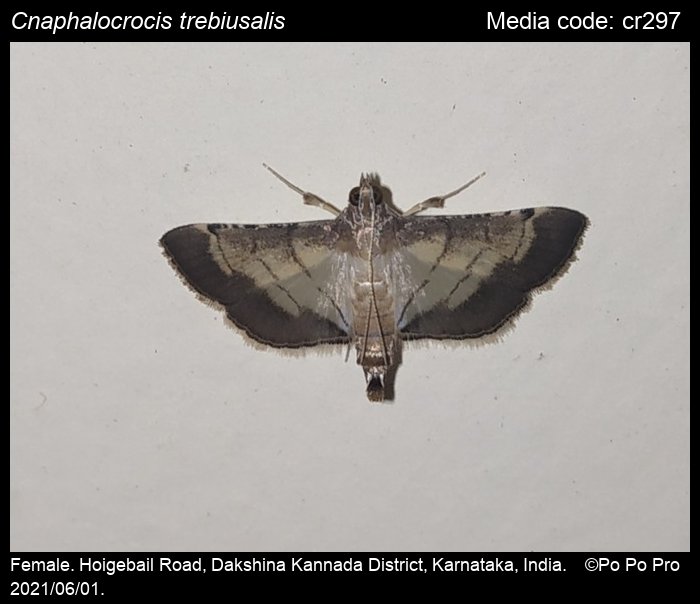Image

Gender (optional)
Life stage
Altitude (optional)
22
Email (of contributor)
krushnamegh@ifoundbutterflies.org
Notes (optional)
The singular reference for the accurate IDing of this species is Francis Walker's holotype itself, though that male has its abdomen missing.
https://oumnh.ox.ac.uk/collections-online#/item/oum-catalogue-3205
This is the only species in the complex that has a characteristic evenly very broad submarginal black band on both wings, and the additional characteristic that the males do not possess the androconial scale patches in the central subcostal region, and both sexes have 7-9 strigae on the costa. Also, the abdomen tip is broad and clearly distinguishable from the other common species.
This is one of the most common and widely distributed Cnaphalocrocis species throughout Asia, and arguably the most common species in India (with the possible exception of C. medinalis). The exceptionally wide distribution is highlighted in this reference, and in Hampson's Vol 4.
https://www.biodiversitylibrary.org/page/16399238#page/351/mode/1up
Strangely, GlobizPyraloidea for some reason doesn't synonymise this species with Epimima stereogona (Meyrick, 1886), though most old references do so, one of them even using the nomenclature Epimima trebiusalis.
https://www.biodiversitylibrary.org/page/23358114#page/475/mode/1up
https://www.biodiversitylibrary.org/page/14676581#page/270/mode/1up (Meyrick's OD, very elaborate)
This is often misidentified as other species on several web sources, like C. poeyalis, C. latimarginalis, etc., but the combination of features leaves no doubt that it is Walker's Botys trebiusalis.
https://oumnh.ox.ac.uk/collections-online#/item/oum-catalogue-3205
This is the only species in the complex that has a characteristic evenly very broad submarginal black band on both wings, and the additional characteristic that the males do not possess the androconial scale patches in the central subcostal region, and both sexes have 7-9 strigae on the costa. Also, the abdomen tip is broad and clearly distinguishable from the other common species.
This is one of the most common and widely distributed Cnaphalocrocis species throughout Asia, and arguably the most common species in India (with the possible exception of C. medinalis). The exceptionally wide distribution is highlighted in this reference, and in Hampson's Vol 4.
https://www.biodiversitylibrary.org/page/16399238#page/351/mode/1up
Strangely, GlobizPyraloidea for some reason doesn't synonymise this species with Epimima stereogona (Meyrick, 1886), though most old references do so, one of them even using the nomenclature Epimima trebiusalis.
https://www.biodiversitylibrary.org/page/23358114#page/475/mode/1up
https://www.biodiversitylibrary.org/page/14676581#page/270/mode/1up (Meyrick's OD, very elaborate)
This is often misidentified as other species on several web sources, like C. poeyalis, C. latimarginalis, etc., but the combination of features leaves no doubt that it is Walker's Botys trebiusalis.
HighLighted Contributions
No
Species Node
Overwrite img

Organism
Butterfly
Moth Taxon search:
Hidden Life stage
Month
June
Year
2021
Day
1
Choose copyright license
Copyrighted (all rights reserved)